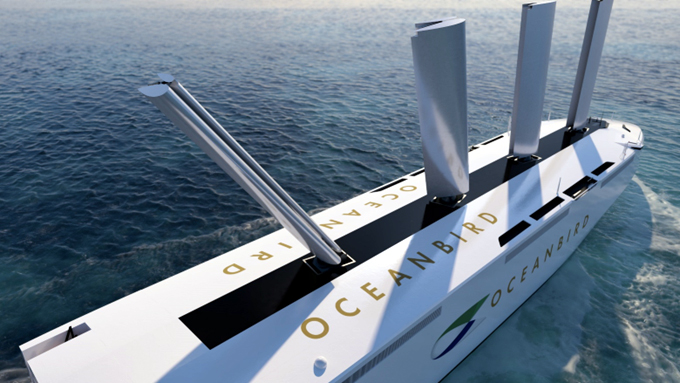Features
Update 2022/8/30
WTech - Shipping
brought to you in part by

Oceanbird – A Shipping Revolution
Swedish Technology will make it possible to power the largest ocean-going cargo vessels by harnessing the wind.
By Suzanne Forcese
“The same aerodynamic forces that power an aircraft to move upwards are powering an Oceanbird vessel to move forward. It’s a combination of lift and drag.” -- Interview with Niclas Dahl, Managing Director at Oceanbird
By Suzanne Forcese

Oceanbird captures the aerodynamics that makes a bird fly and recognizes which routes are optimal for wind-powered shipping. The wing consists of a core and a flap, optimizing the aerodynamic forces. The wing can be folded and tilted allowing the vessel to pass under bridges and to reduce the power in hard weather. Image courtesy Oceanbird
WT: Please tell us about the consortium that created Oceanbird. When did the idea of the project originate? When do you expect the project to reach completion?
Dahl: The shipping company Wallenius Marine started working on a roadmap to zero emissions over ten years ago. With the aim to find ways for emission-free shipping, a project group evaluated several renewable resources like solar panels, wave energy etc.
They found that the most power is in harvesting the wind.
A government-funded research project involving Wallenius Marine, KTH Royal Institute of Technology and SSPA (a Swedish Maritime Solutions partner), started in 2019. In September 2020, the consortium presented the Oceanbird concept. To develop the wing sail technology, Wallenius founded a company together with Alfa Laval called Alfa Wall Oceanbird.
The project will end this year, but we will still collaborate with this efficient cluster of experts.
WT: What was the impetus to develop Oceanbird? Why are you revolutionizing the shipping industry?
Dahl: Shipping is an energy-efficient way of transporting goods. Despite this, shipping needs to become more sustainable. Maritime transport emits around 940 million tonnes of CO2 annually and is responsible for about 3% of global greenhouse gas emissions, even more than airplanes. If the industry was a country, it would be the sixth biggest polluter, above Germany.
These emissions are projected to increase significantly if mitigation measures are not put in place swiftly. If we continue business-as-usual, the emissions will increase by 50%-250% by 2050, according to International Maritime Organization (IMO).
IMO has set a goal of reducing CO2 emissions by 40% per transport work from international shipping by 2030 compared to 2008.
Oceanbird wants to take decarbonization one step further, contributing to changing, updating, and remodelling an entire industry.
The Oceanbird Concept – Wings on Water
WT: It appears that you are taking a step back in time and fast-forwarding to the future simultaneously. What is the “old” technology that the Oceanbird is based on?
Dahl: It is more of an old principle, that you can use the power of the wind to move forward. The technology with stiff wing sails controlled by sensors and advanced control systems is new.
WT: How does the Oceanbird technology compare to the wings on aircraft? Please tell us about the wing sails.
Dahl: The same aerodynamic forces that power an airplane to move upwards, are powering an Oceanbird vessel to move forward. It is a combination of lift and drag.
The telescopic wing sails were in an initial design, which we have upgraded. They are now half the size but show the same performance, which is more sustainable since they are much lighter and require fewer materials being produced. The wing consists of a core and a flap and can be folded and tilted
WT: How is the wing design more sustainable?
Dahl: A 90% reduction in emissions compared to traditional sailing methods is the claim of Oceanbird.
The 90% reduction is in the whole concept: specially designed hull, wing sails and speed/route recommendations.
KTH University has done advanced simulations showing that this is possible, given that the ship owner follows all recommendations.
If we are talking about one wing sail on an existing ship, each wing sail will save around half a million litres of fuel (480,000 litres), equal to 3,000 barrels of diesel a year. The calculations are based on wind probabilities along main trading routes, provided by IMO.
WT: In addition to reduced emissions, what other benefits are there to mastering the wind in trans-ocean cargo shipping?
Dahl: Oceanbird will also decrease sound pollution in the water. The Oceanbird vessels would be far quieter since there will be no sounds from generators or engines but propeller cavitation. This will mean a lot for whales and other marine mammals which depend on hearing for navigation, reproduction, and finding food.
WT: Has this design been attempted by anyone else?
Dahl: Not exactly this design, but there are other wind power solutions in shipping. One challenge is to provide enough power to transport heavy cargo and make a substantial reduction in emissions. Another is a free line of sight if there are wing sails in front of the bridge.
WT: Could this have been accomplished two decades ago?
Dahl: Probably not. The customer demands combined with new emission legislation and higher fuel prices are making the development go a lot faster.
Sailing Forward
WT: What’s next for Oceanbird?
Dahl: We are now finalizing the design and will order the first full-scale prototype during the fall. We will do a land-based installation in the end of next year and a vessel-based in the spring of 2024.
WT: Please describe the ship.
Dahl: The first vessel from the Oceanbird concept will be a car carrier able to transport around 7,000 cars and trucks that can roll on and roll off (RoRo). If sailing in an average speed of 10 knots, it will take 12 instead of 8 days to cross the Atlantic. The concept is based on a 200 metres long and 40 metres wide cargo vessel. To be able to get in and out of harbours – and as a safety measure and to be able to keep a schedule – the vessel will also be equipped with an auxiliary engine, powered by the best alternative available today.
Our aim is to sail the first Oceanbird vessel in 2026, and so far, it looks promising.
Here’s a sneak preview
WT: One last drop. Please leave all of us with something to think about.
Dahl: Thousands of years have passed since we learned to harness the wind so that ships could travel faster and further.
The wind helped us discover our planet. Now it can help us preserve it.
suzanne.f@watertoday.ca
|